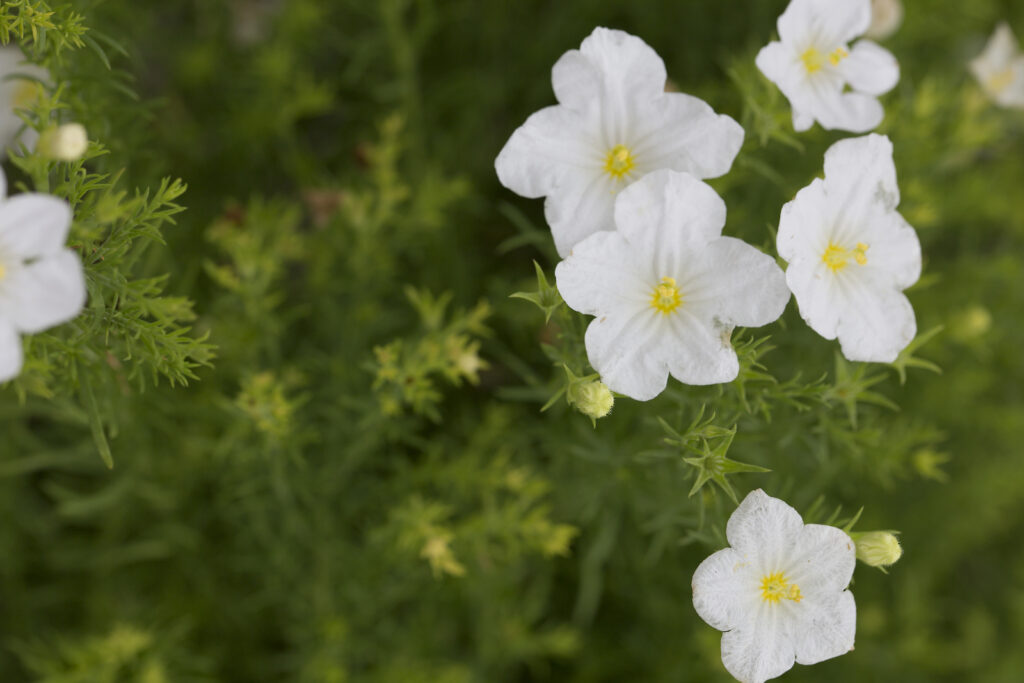Nierembergia–commonly called Cupflower–bears open cup- or bell-shaped, sometimes tubular white or light blue flowers in summer. It can be spreading or upright in form with alternate leaves.
Nierembergia is usually grown as an annual; it is a perennial in mild-winter regions. Plants grow best where summers are cool. Where summers are hot, Nierembergia will need additional water and afternoon shade.
Nierembergia is a genus of more than 20 species; some are annuals and some are perennials. Most perennial species are frost tender but they are easily propagated and are often grown as annuals.
Nierembergia is a good choice to plant as bedding, as border edging, or in containers.
Good Products for Garden Care at Amazon:
- Garden Safe Snail and Slug Bait
- Bonide Sulfur Fungicide
- Monterey BT Caterpillar Killer
- Neem Bliss 100-% Cold Pressed Neem Oil
- Safer Brand Insect Killing Soap
- PyGanic Botanical Insecticide
Get to know Nierembergia
- Plant type: Annual or short-lived perennial in Zones 7-10
- Growing Zones and range: Zones 7 to 10
- Hardiness: Frost tender; grow as a cool-season annual; in Zones 8-9 grow as a perennial
- Height and width: 10 inches (25cm) tall and wide
- Foliage: Delicate, threadlike 1/2 inch long leaves
- Flowers: Open cup- or bell-shaped, sometimes tubular flowers
- Flower colors: Blue, white, and violet
- Bloom time: Summer into Fall
- Uses: Edging or front of mixed borders, mass as bedding, containers
- Common name: Cupflower
- Botanical name: Nierembergia
- Family: Solanaceae
- Origin: Temperate South America
Where to plant Nierembergia
- Grow Nierembergia in full sun in cool summer regions in Zones 3-6. Grow in part shade in hot summer areas of Zones 7-11.
- Plant Nierembergia in humus-rich, well-drained soil.
Nierembergia uses
- Use Nierembergia as bedding, as border edging, or in a container.
- Nierembergia’s spreading, flowering habit suits it for window boxes or hanging baskets.

When to plant Nierembergia
- Set established Nierembergia in late winter or in spring a week or two before the last frost date.
Planting and spacing Nierembergia
- Space Nierembergia about 10 inches apart. Plant in a mass of 10 plants or more for best effect.
How to water and feed Nierembergia
- Nierembergia needs ample moisture; keep the soil evenly moist.
- Fertilize Nierembergia occasionally with an all-purpose fertilizer.
Nierembergia care
- Mulch around Nierembergia to conserve soil moisture.
- Cut Nierembergia back by one-third after flowering to prompt new blooms.
Nierembergia pests and diseases
- Nierembergia is susceptible to aphids and whiteflies and can be damaged by slugs and snails.
- Nierembergia can be infected by tobacco mosaic virus.
Nierembergia propagation
- Sow seed in autumn for spring flowering.
- Seeds germinate in 15 to 25 days at 70° to 75°F (21°-24°C). Seedlings can withstand frost; transplants can be set in the garden 2 ro 3 weeks before the last frost.
- Take stem tip cuttings of tender perennials any time during summer.
Nierembergia varieties to grow
- Nierembergia caerulea: upright branching perennial with downy stems; cup-shaped lavender-blue flowers bloom through summer; ‘Mont Blanc’ and ‘Violet Robe’ are favorite cultivars.
- N. repens, white cup: creeping, mat-forming bears open bell-shaped yellow-centered white flowers; cultivar ‘Violet Queen’ produces rich purple flowers.
- N. scoparia: shrubby perennial with numerous pale blue flowers that fade to white at the margins; blooms from midsummer into early autumn.
Nierembergia frequently asked questions
Q: What is the best way to grow Nierembergia from seed?
A: Start indoors in February or early March for early bloom. Seeds need 10 to 12 weeks to mature into flowering plants.
Q: How’s the best way to grow Nierembergia in the garden?
A: Plant nierembergia in full sun or light shade. Keep the soil just moist. Fertilize monthly with an organic soluble plant food.
Related Articles:
- 20 Perennials That Bloom for 6 to 8 Weeks
- Shrubs with Showy Flowers Season-by-Season
- Trees in Garden Design
- Growing Annuals for Summer Bloom
- Trees—click here for more articles
- Shrubs—click here for more articles
- Perennials—click here to see more
- Annuals—click here to see more















